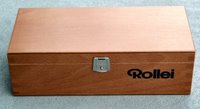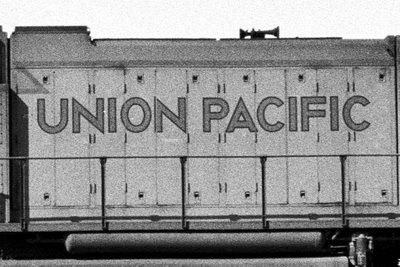Rollei Pan 25 Film
Last year, we seemed to be down to one readily-available slow B&W film, namely, Ilford Pan F+. The old Adox KB14 (ISO 25) has been re-released under different names, but that was not an easy film to use. I found several reasons to steer away from it. It was too tightly-coiled to easily feed into a reel, the wet emulsion seemed overly soft and easily damaged, and the film base was dark purple.
In recent years, we have seen the demise of the slow Kodak Panatomic-X and more recently, Agfa APX 25. Ilford Pan F + (ISO 50) is so close grain-wise to the recently released Fujifilm Acros 100, I usually use the latter to get that additional f/stop of speed. Specialty films that can be developed for full tonal scale (such as Bluefire Police film) are still available for extremely fine grain and high resolution, but finding a readily-available suitable developer for them is difficult.
Enter Rollei Pan 25, a newly released film that nobody really seems to know very well. I have read that it is a relabeled specialty film, but others have said that it is an entirely new film. I tend to believe the former rather than the latter, especially after reading this on the Massive Dev Chart.
Rollei films are the same as Maco films. The published times are identical (subject to revision), so simply refer to the relevant Maco chart for the development information you require. We are awaiting further clarification on this product line, but the type/speed of the Maco films should indicate which Rollei film is the equivalent product. More information will be published as it becomes available. (www.digitaltruth.com)
 price by not packaging it in a gift box. Inside the box are ten rolls of film in black canisters. Things are not quite as fancy inside the box. The labels on the canisters have print with jaggy edges reminiscent of the output of my first Epson dot matrix printer. But I cannot complain. Most canisters have no label, so the funky one here is a plus. On the film cassette is pretty much the same label as on the canister. There is no DX code on the cassette, so you'll have to set the camera's ISO manually.
price by not packaging it in a gift box. Inside the box are ten rolls of film in black canisters. Things are not quite as fancy inside the box. The labels on the canisters have print with jaggy edges reminiscent of the output of my first Epson dot matrix printer. But I cannot complain. Most canisters have no label, so the funky one here is a plus. On the film cassette is pretty much the same label as on the canister. There is no DX code on the cassette, so you'll have to set the camera's ISO manually.
 So much for the idiosyncratic packaging. How good is the film? Slow black and white films are notorious for narrow latitude, which is one reason why they fell out of favor. I don’t know many people (me included) who do much routine bracketing these days. I don’t have many subjects that will sit still that long. But to be fair to the film, I committed myself to trying to make the exposures as accurate as possible. And I decided to use the Cosina Voigtländer 50/3.5 Heliar lens, a reputably great performer. And to tame the high contrast I expected to get (the
So much for the idiosyncratic packaging. How good is the film? Slow black and white films are notorious for narrow latitude, which is one reason why they fell out of favor. I don’t know many people (me included) who do much routine bracketing these days. I don’t have many subjects that will sit still that long. But to be fair to the film, I committed myself to trying to make the exposures as accurate as possible. And I decided to use the Cosina Voigtländer 50/3.5 Heliar lens, a reputably great performer. And to tame the high contrast I expected to get (the 
The results were good but not spectacular. A full frame, unadulterated scan shows decent sharpness and tonal scale when printed. An unadulterated enlargement of a small portion from the center of the picture retains good detail with some apparent grain. I’m not sure that D-23 was the best developer to use on this film. PMK Pyro may be a better choice in that it tends to minimize the appearance of grain. Still, I don’t think I would have any trouble enlarging something to 16x20.

The question that faces me is would I want to make Rollei Pan 25 a regular item in my bag? Twenty years ago (given the choices of slow film available), I would probably say no. It is just too slow. Today? Probably no. If I want very fine grain, I would opt for one of the chromogenic 400 ISO black and white films. Although I would have to wait a week to get the film back from the lab, Kodak BW400CN (1) is cheaper, (2) is faster by a whopping four f-stops, (3) has much nicer scale, and (4) allows me to use digital ICE technology to remove dust spots.


<< Home